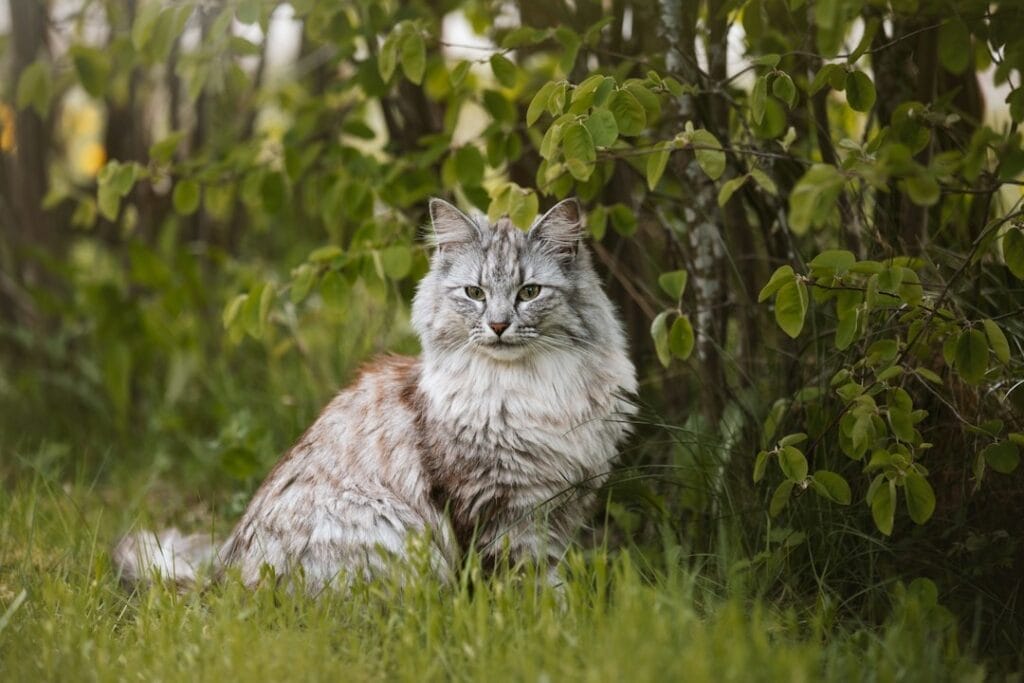Picture a Maine Coon lounging on your couch, its majestic fur spilling over the cushions—a gentle giant in your living room. Big cats like this one aren’t prowling the wilds; they’re plopping down next to us with purrs that rumble like distant thunder.
Dive into their world, and you’ll find there’s more than meets the eye. We’re not just talking about fluff balls here; we’ve got breeds stemming from forest dwellers to those with an exotic twist of wild bloodlines.
Big cats are stunning companions who bring a slice of untamed nature right into our homes, but caring for them is another ballgame altogether—think habitat needs to be tailored to mimic wide-open spaces and diets designed for optimal health. Stick around as we unravel these mysteries together.
Table Of Contents:
- Maine Coon
- The Domestic Big Cat Breeds
- Habitat Needs for Large Domestic Cats
- Feeding Large Domestic Cats
- Health Issues Common in Domestic Big Cats
- Enhancing Longevity in Large Pet Cats
- Purrrrrrfect Summary
 Maine Coon
Maine Coon
The Domestic Big Cat Breeds
If you’re looking for a feline friend who makes a big impression, these top seven largest domestic cat breeds might just be your match. Each of these breeds brings something unique to the table – from their size and personality down to those adorable quirks we all love about cats.
Maine Coon – The Gentle Giant
Meet the Maine Coon, often referred to as America’s breed. These fluffy titans can weigh up to 18 pounds or more. They are known not only for their impressive size but also for being sociable butterflies with dog-like traits. Similar in demeanor to some gentle giant dog breeds, they enjoy playing fetch and may even follow you around like an oversized shadow.
Savannah Cat – The Wild at Heart
The Savannah cat is where wild meets domestic; it’s like having your own mini cheetah that purrs. A blend between a regular house cat and an African serval, this hybrid is sleek, athletic, and loves heights—think kitchen cabinets as its personal jungle gym.
Ragdoll – The Floppy Friend
Ragdolls tip the scales on both weight charts and charm meters, thanks largely to their piercing blue eyes, which are pretty hard to resist. True enough, when picked up, they tend to go limp, earning them the name ‘Ragdoll.’ Imagine holding a large teddy bear gives head bumps, nuzzles, and return cuddle sessions—it doesn’t get much sweeter than this.
Norwegian Forest Cat – The Nordic Beauty
Last but certainly not least, Norwegian forest cats exude Viking vibes with their lush coats built to withstand Norway’s harsh climate. Their origin story suggests a lineage as rugged as the Vikings themselves. Perhaps most impressively, despite their substantial bulkiness, they are agile climbers who prefer to survey their domain from high vantage points—indoors or outdoors alike. So if you’ve got shelves that need filling, the Norsk Skogkatt—as Scandinavians call them—might be the perfect choice.
Key Takeaway:
Looking for a large feline friend? Check out the Maine Coon, Savannah Cat, Ragdoll, and Norwegian Forest Cat. These big breeds boast unique traits like sociability, wild spirits, cuddliness, and rugged beauty—plus some dog-like qualities too.
Habitat Needs for Large Domestic Cats
Like their wild counterparts, big domestic cat breeds crave space to roam and climb. Imagine your indoor habitat as a scaled-down jungle gym. It’s essential to recreate the vertical spaces these cats naturally seek out.
The National Wildlife Federation highlights how enriching an indoor environment is key to keeping your feline friend happy. Activities that mimic outdoor experiences can help satisfy their instinctual behaviors. For example, high perches let them survey their domain while scratching posts double as tree trunks they’d claw in the wild.
Mimicking natural habitats isn’t just about fun; it helps stave off boredom and keeps those hunter instincts sharp. So go ahead, transform your living room into a big cat-friendly zone—it’ll be purr-fect for both of you.
Get everything you need to make your big cat feel right at home.
Feeding Large Domestic Cats
When it comes to feeding your large domestic cat, think king of the jungle rather than alley prowler. These majestic felines require a diet that supports their grandeur and keeps them purring with vitality. For instance, Maine Coons don’t just boast impressive manes; they need high-quality proteins to maintain those luxurious coats.
The Savannah Cat may look like it belongs in the wilds of Africa, but its dinner plate should reflect a balanced domesticated diet—rich in protein and nutrients—to fuel its adventurous spirit without turning your living room into a savanna hunt.
Ragdolls might flop around easily, but when mealtime rolls around, these gentle giants crave more than cuddles—they want hearty meals tailored for their substantial size.
Keeping indoor cats happy, after all, isn’t just about toys and attention; it’s also about mimicking the robust dietary patterns they would naturally enjoy outside. So let’s give our big buddies what they truly deserve: A feast fit for the apex predators they are at heart.
Health Issues Common in Domestic Big Cat
When it comes to our feline friends of considerable size, we’re talking Maine Coons and Savannahs that can tip the scales way more than your average house cat. But their grandeur doesn’t shield them from health issues; their large stature may make them prone to certain conditions.
Maine Coons are known for heart conditions like hypertrophic cardiomyopathy, while Savannah Cats need careful breeding to avoid genetic health problems. Longevity hinges on early detection and intervention. Regular vet check-ups are crucial because catching something early could make a difference.
Diet plays a starring role, too—it’s not just about portion control but also ensuring the nutritional balance is spot-on for these big boys and girls. After all, what fuels them can either fortify or fail their mighty bodies over time.
If you have questions about the health of your big cat, you can sign up for an online vet consultation with Ask A Veterinarian. They are available 24/7 to answer questions.
To avoid unexpected health costs, check out Pet Assure Mint.
Enhancing Longevity in Large Pet Cats
Owning a majestic large breed cat comes with the joy of their presence and the responsibility to ensure they live long healthy lives. Let’s get into some practical strategies to boost your pet’s average lifespan.
Nutrition Tailored for Big Appetites
Diet plays a crucial role in longevity. These larger-than-life feline friends need high-quality food that matches their energy levels. Keep them purring with balanced meals—think premium proteins and essential nutrients—and watch portion sizes to prevent obesity.
Creating an Enriching Habitat Indoors
Your indoor lion requires space to stretch those lengthy limbs. Mimic outdoor adventures indoors, complete with climbing structures and interactive toys, so boredom never becomes an issue.
Proactive Health Care Checks
No one likes vet visits, but regular check-ups are non-negotiable for spotting health issues early on—a key factor in longevity for big cat breeds like Maine Coons or Savannahs. From heart conditions to joint care, staying ahead is always better than catching up when it comes to health.
Purrrrrrfect Summary
So, you’ve journeyed through the world of big cats. You now know Maine Coons aren’t just fluffy; they’re friendly titans in your living room. Savannah Cats? They’re domesticated yet wild at heart.
Caring for these large breeds means more than just space—they need habitats that echo their grandeur and diets crafted for kings. Healthwise, being proactive is key to dodging common issues and adding years to their lives.
Remember this: Ensuring the happiness of our feline friends starts with understanding them—inside out, from whisker tip to tail end. It’s about conservation, too; what we learn from home can help those in the wild stay there.
Let’s embrace these majestic creatures responsibly, nurturing every purr and pouncing. Because when it comes down to it, making sure our beloved pets thrive is as rewarding as having them by our side.


